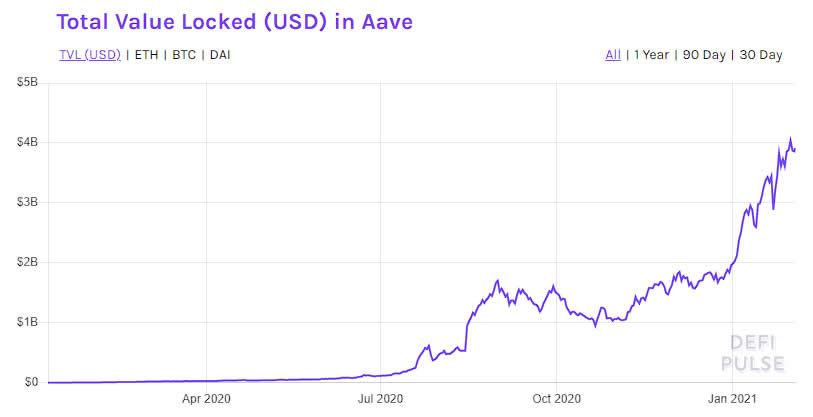As part of BeInCrypto’s decentralized finance (DeFi) deep dive series, we’ll take a look at the world’s second most popular decentralized finance protocol, at the time of writing, Aave (AAVE).
It was originally launched as ETHLend, a crypto asset lending platform that was founded in 2017 by Helsinki-based programmer, Stani Kulechov. The ETHLend initial coin offering (ICO) was held in November 2017 and raised $600,000 worth of ether (ETH) which was used to create 1 billion LEND tokens, among other things.
The name Aave comes from the Finnish word for “ghost,” and the protocol was rebranded to reflect this, in September 2018. The Aave protocol went live on mainnet in January 2020, supporting 16 assets, at the time. In July 2020, Aave announced a $3 million investment from Three Arrows Capital, Framework Ventures, and Parafi Capital.
2020 was a huge year for Aave as its total value locked surged over 560%, from around $300,000 to top $2 billion, by the end of the year. If that wasn’t impressive enough, its rebased AAVE token was the best performing DeFi asset of 2020, skyrocketing over 5,000% in value.
The protocol currently has around $4 billion in collateral lockup and has been through a number of audits and security checks.
Flash loans and how it works
Aave initially launched touting itself as a flash loan platform, but it has since grown to become much more than that.
The protocol enabled a customized smart contract to borrow assets from its reserve pools within one transaction on the condition that the liquidity is returned to the pool before the transaction ends. No collateral was needed which was a first for the largely over-collateralized DeFi sector, at the time.
If the collateral was not repaid, the transaction would be reversed to effectively undo the actions executed until that point, guaranteeing the safety of the funds in the reserve pool.
Flash loans got a really bad reputation in 2020, as they were repeatedly used to exploit a number of DeFi protocols. A flash loan exploit doesn’t necessarily involve a hack or broken code, it can simply take advantage of flaws in the design of a system.
Over the course of the year, a number of DeFi protocols were attacked using the flash loan vector, and these included bZx (twice), Balancer, Harvest Finance, Value Protocol, Pickle Finance, Warp Finance, and several others. Aave was not exploited and remains one of the more secure DeFi platforms, at the time of writing.
Flash loans are only a part of what Aave offers. Being a lending platform, collateral providers can lock their digital assets into various pools in order to earn interest.
It offers stable rate loans which behave as a fixed rate loan in the short-term, but can be re-balanced in the long-term to respond to severe changes in market conditions. Perpetual loans also give users the freedom to get liquidity from their deposits without any duration or repayment schedule.
Aave works with aTokens which are issued by the protocol to represent collateral deposited in a lending smart contract on a one-to-one basis. Lenders earn interest on these tokens which are burned when redeemed and the collateral is repaid. Deposits can be made in crypto assets or fiat through a number of wallet and payment partners.
Aave tokenomics: “aavenomics”
In July 2020, Aave founder Kulechov announced a big shakeup in the protocol’s tokenomics which involved a massive debasing and rebranding of the token from LEND to AAVE. The so called ‘”avenomics” upgrade proposal converted every 100 LEND tokens into 1 AAVE token, with a maximum total supply capped at 16 million, down from 1.3 billion.
The inaugural governance vote happened at the end of September and was passed with a 100% majority. Of the new total supply, 13 million of those tokens were redeemed by LEND holders while the remaining three million went into the Ecosystem Reserve which it described as a bootstrap fund allocated to protocol incentives as governance saw fit.
In addition to the token rebasing was the launch of a Safety Module which acted as a staking mechanism for tokens to act as insurance against shortfall events. The staking pool introduced AAVE token farming incentives so that stakers could earn “Safety Incentives,” in addition to a percentage of protocol fees.
By mid-October 2020, the new AAVE token was trading at a premium, as the big bag holders began migrating their stashes pushing prices above $50. At the beginning of 2020, LEND was priced at just $0.02, so even with a one hundred times supply cut and a new rebalanced price of $2, it was still up by 2,400%, and there was more to come.
The primary goal of aavenomics was to further decentralize the protocol though token holder based governance which would become the norm for the majority of DeFi protocols.

Aave v2 upgrade
In December 2020, Aave continued hitting roadmap targets and upgraded its platform with a version two launch. The upgrade ushered in a number of significant improvements including the ability to repay part of the loan collateral without having to conduct multiple transactions, rolling this operation into one transaction to save in network fees, time, and effort for users.
The tokenization of debt positions also facilitated native credit delegation within the Aave protocol, enabling more efficient position management for lenders and borrowers. The upgrade also introduced stable borrowing rates and fixed interest rates to provide greater predictability and avoid losses due to market volatility.
Margin borrowing was enabled which allowed users to directly take long and short leveraged positions on any of the assets supported without using third-party services. There were also numerous improvements to flash loan functionality and operations.
Version 2 of Aave’s aTokens integrated an Ethereum Improvement Proposal (EIP) for gasless approvals, with the end goal of scaling by running on Layer 2 technology. There were also a number of gas optimizations further reducing the burden of network fees which were extremely high at the time.
By the end of 2020, Aave was one of the top DeFi protocols in terms for total value locked and token price performance. Its total value locked (TVL) had surged from just $300,000 or so to over $2 billion throughout the year and the AAVE token was the best performing DeFi asset for 2020, skyrocketing in price by an epic 5,000%.

Aave into 2021
The momentum for Aave did not end with the year and has pushed forward into 2021, as the protocol continues to innovate and forge new industry partnerships.
In January 2020, a year after it was launched, Aave released a migration tool enabling users to seamlessly migrate their positions from version 1 to the recently launched version 2. It added that version 1 contracts will remain on Ethereum, but the future of the protocol is now firmly with version 2.
Also in January, Aave launched the closest thing to its own Layer 2 scaling solution by allowing its aTokens to be ported to the Plasma powered Matic Network. The ultimate goal for the protocol, however, is full Layer 2 operations but that is likely to come with the next major upgrade.
At the time of writing, the total liquidity on both versions of the Aave protocol had topped $4 billion according to DeFi Pulse, though Aavewatch reported a lower figure.
DeFi Pulse had also listed it as the second largest protocol in terms of TVL, behind DeFi stalwart MakerDAO which had $5.5 billion, at the time of writing. Aave held 13.3% of the entire amount of liquidity locked across the DeFi ecosystem by early February.
Token prices for AAVE hit an all-time high just over $310 on Jan. 31, 2020, according to Coingecko, representing a monumental gain since it was rebased the previous year. Even institutional crypto funds such as Grayscale have been eyeing Aave for their next trusts indicating how much confidence has grown in the platform over the past year.
The last enticing tweet from founder Kulechov, at the time of writing, was of an Aave’s themed credit/debit card, so who knows what is next in the pipeline from this DeFi giant that just keeps on growing.
Disclaimer
In compliance with the Trust Project guidelines, this opinion article presents the author’s perspective and may not necessarily reflect the views of BeInCrypto. BeInCrypto remains committed to transparent reporting and upholding the highest standards of journalism. Readers are advised to verify information independently and consult with a professional before making decisions based on this content. Please note that our Terms and Conditions, Privacy Policy, and Disclaimers have been updated.


